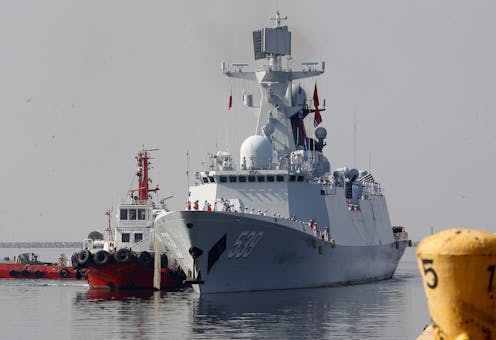what was the Chinese laser attack about and why does it matter?
- Written by John Blaxland, Professor, Strategic and Defence Studies Centre, Australian National University

Just after midnight last Thursday, a transiting Chinese People’s Liberation Army Navy (PLA-N) vessel shone a military-grade laser at an Australian air force plane conducting coastal maritime surveillance.
This did not happen in the South China Sea near China’s coastline, but rather in the Arafura Sea, within Australia’s exclusive economic zone off the north coast of the country. From what we can ascertain, this is the closest an attempt at military intimidation by China has gotten to our shores.
The Chinese vessel has since steamed through the Torres Strait at the northern tip of Queensland accompanied by another PLA-N ship, heading towards the Coral Sea off the Great Barrier Reef.
They may be intending to monitor upcoming Australian military exercises off the Queensland coast, which is a legitimate act as long as the ships stay outside Australia’s territorial waters, which stretch 12 nautical miles from the coast.
The laser pointing, though, was not a legitimate or appropriate act.
The Department of Defence condemned “the unprofessional and unsafe military conduct” by the Chinese ship. This was quickly followed up by Prime Minister Scott Morrison declaring the incident an “act of intimidation” that put military lives at risk. Defence Minister Peter Dutton labelled it an “aggressive, bullying act”.
In seeking to put this in context, it’s important to understand what a laser attack is, what these lasers are used for, and how dangerous they are. We also need to consider the possible reasons China would engage in such an act.
What are laser attacks?
All modern warships are equipped with lasers. These are used largely to determine the firing range and designate a target immediately before discharging a weapon. It is routinely practiced against dummy targets.
It is considered dangerous for at least two reasons. Pointing a laser is often referred to as “painting a target” before firing live munitions, such as artillery shells, machine guns or missiles. It is widely seen as a hostile act, just short of crossing the threshold of open conflict or war.
This is because laser pointing is separated from firing a missile with hostile intent by a mere split second. This can be a nerve-wracking experience for those subjected to such beams.
In addition, laser beams themselves are dangerous because they can cause permanent blindness if shone into someone’s eyes, as well as damage to important navigational and other related systems critical to air safety.
Laser pointers were popular in schools for a while until the potential for harm was recognised. These lasers are exponentially more powerful and harmful.
So, why would China do this?
Naval vessels operating in the contested waters of the South China Sea are frequently confronted by PLA-N, Chinese Coast Guard and Chinese militia vessels.
And these Chinese vessels have been engaging in this kind of behaviour for some time against Australian, US and other aircraft.
This kind of assertive and adversarial behaviour is not what is normally expected in uncontested waters closer to Australia – or within any nation’s exclusive economic zone. This is also not a tactic known to have been used by Australia against other nations’ naval vessels, particularly not close to or within China’s exclusive economic zone. So, this seems to be an escalation.
Read more: Does the US have the right to sail warships through the South China Sea? And can China stop them?
China may be seeking to send a message to Canberra that its naval patrols in the South China Sea are not welcome. The US Navy also engages in these patrols – calling them Freedom of Navigation Operations, or FONOPS – as do other nations such as Japan, the UK and France.
China sees these FONOPS as provocative, given it claims nearly the entirety of the South China Sea contained within the so-called “nine dash line”. The Permanent Court of Arbitration at The Hague dismissed China’s maritime claims in 2016 and upheld the application of the UN Convention on the Law of the Sea (UNCLOS), but China wants to re-write the rules regardless.
How should Australia respond?
There are two obvious deductions to make from the events over the past few days. First, China is ratcheting up its pressure on Australia. Second, Australian politicians remain prepared, eager even, to use heightened tensions with China to draw attention to themselves in the lead-up to the election.
With the stakes rising, and an election looming, there is a need for issues like this to be handled firmly, but delicately. We must avoid making undue concessions to China’s adversarial tactics, while also seeking to avoid escalation and politicisation of an issue of significant importance to the future security and stability of the region.
In considering how best to manage this in the future, Australian diplomats should be looking to enlist the support of nations in the region, such as the member states of ASEAN, our Quad partners (India, Japan and the US) and beyond.
Read more: Explainer: why is the South China Sea such a hotly contested region?
There is strength in solidarity. China is testing to see what limits it can reach while demonstrably avoiding crossing the threshold with an act of war.
Beijing knows that openly provoking conflict will have major repercussions for the country’s reputation and image. It also doesn’t want to damage its attempts to undermine American and US-aligned security policies supportive of the Court of Arbitration ruling on the South China Sea.
Australia’s actions have an effect on the region. Our neighbours in Southeast Asia and the Pacific will be watching closely to see where the limits of our tolerance lie and how far we are willing to push back against Chinese assertiveness – without crossing the threshold of open conflict, as well.
Authors: John Blaxland, Professor, Strategic and Defence Studies Centre, Australian National University





